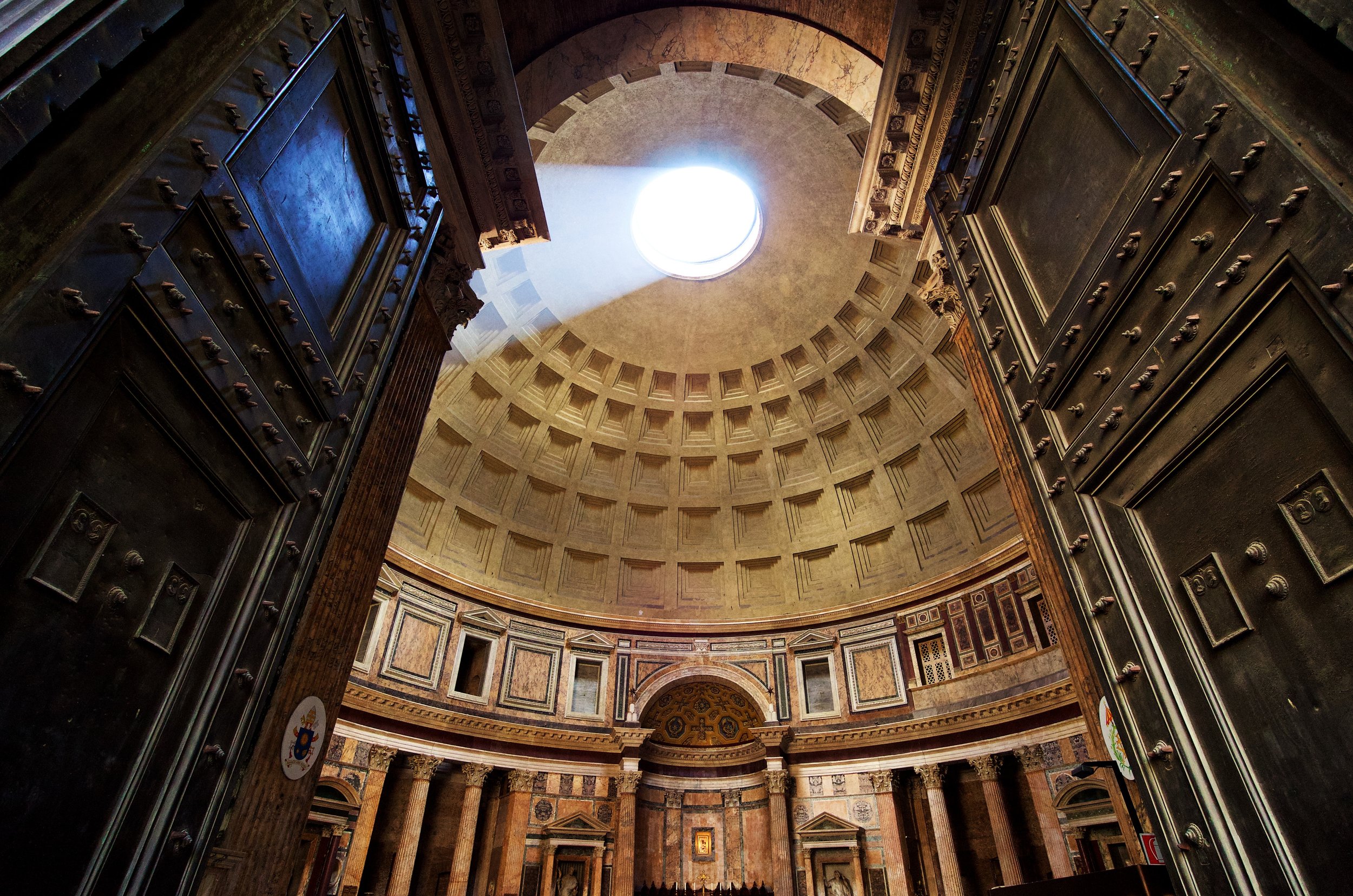The Long Commute: From Ancient Scrolls to Modern Screens

Benjamin Harnett works as a digital engineer in a fast-paced Manhattan newsroom, but in his off-hours he studies the Classics. His fascination with the codex—reading technology of Ancient Rome and Greece—reveals an astonishing insight into the future flux and flow of information.
I still get the paper delivered on the weekends, at our new house in Beacon. If I’m up early enough, I can hear it hit the porch. Sometimes it doesn’t quite clear the fence, and bounces to the curb. When it does I wait to get it, unprepared so early for the enthusiasm of our dog dashing out and tripping up my feet, for the loud squeak of the gate, for the neighbor silently judging my morning outfit, a clash of plaids. It’s OK, I’ve already read most of the articles I’m interested in, either yesterday on the train on the long commute home beside the Hudson, or in bed, in the glow of my phone, inches from my face, scrolling with my thumb. Still, the physical paper is good for starting fires, and to scrub the windows to a brilliant shine.
In ten years I’ve gone from penciling answers for the crossword into gray newsprint to plunking the letters onto digital squares without the sense of loss I might have imagined. I carry a couple so-called “paper” books in my bag, but an iPad too, with a hundred others for my different moods. No one has to fold their newspaper on the subway, the way my mother taught me at breakfast one morning; the newspaper has folded itself into our screens. I have seen the digital revolution from the other side, too, since my day-job as a digital engineer for a newspaper is to see that the bits keep flowing. But it has not been a change without anxiety.
For the longest time a newspaper was a newspaper. Sure they shrank over time in every direction—ads found their way to the front, sections joined together, or spawned anew, color splashed its way through the pages—but for every “innovation,” it was the same stuff: a day or week of news compressed into cheap paper, grabbed from a stand or a vending box outside the coffee shop, or dropped like a cut of meat, fresh on your front step. What was a day’s news is become an hour’s. There’s less money, more pressure. It feels inevitable, and mysterious at once, like a sudden change of weather. People were predicting it, but it’s not the same as the drop in the light, and the cold on your skin.
“A book’s form isn’t easily known. These are the records of fragments, bits of antiquity recovered after being blown apart by the disaster of time.”
*
Just before Christmas, the year after the 2012 election, at work everyone is talking about the internal “innovation report” in progress, which we know will have a somewhat critical take on how we’re handling the digital transition. Outside of work, I am engaged in a project of my own. It began while I was closing out a long-neglected Master’s Degree in Classics. In the midst of a universal preoccupation with the future, I retreat, off-assignment, into the distant past.
Once or twice a week, that autumn, after work, as the sun sank over the river with a crimson majesty, I had been popping into the subway, and, instead of pushing directly through the turnstiles there, turning right, then right again, to follow the long tunnel to Times Sq., then wedging myself onto the 2/3 or 1 trains, the same red as our office walls, emerging, at last, from the underworld, to 116th st. and the Columbia University gates.
Ensconced in the first few centuries of our era, I read poems by Martial, the letters of Pliny the Younger, the scene of Augustine’s conversion, extracts of the jurists Paulus and Ulpian, and a meditation on loss by the famous Greek physician Galen. I read commentaries on these, scholarly essays, monographs and books. A mystery tying everything together has me up, late at night at my “desk,” our tiny dining table in our galley kitchen in our last apartment on the third story of a brownstone in Brooklyn, tapping in to my skills as an engineer on a hunt for data.
The only light is a cool blue one from my laptop screen, and I am tabbing back and forth between two windows comparing entries in a database to search results on a page. I have been devoting an hour or so to this part-hypnotic, part-maddening task each evening after dinner, after work, for the past week.
The database entries are blurring together, 4,757 records of ancient books from a website with a dark red header, a pale body, some color-coded stats, and an advanced search into which I have entered:
→ “Provenance: Egypt”
→ “Language/script: Greek”
→ “Bookform: ‘roll’ or ‘codex’”
For some reason, my numbers aren’t adding up. I waste hours before realizing my mistake. A book’s form isn’t easily known. These are the records of fragments, bits of antiquity recovered after being blown apart by the disaster of time.
I’ve held some of these fragments (in their protective cases), two-thousand or more years old, yellowed, brittle, papyrus-fibers torn at the edges. The original papyrus was supple, strong, and pale, taking Greek characters in dark ink, in careful hands. The expense of a book was its scribing. The “roll” or volumen (in Latin), was the book, hence a “volume.” And it was that way for millennia, a scroll, with writing on one side, held in two hands, unrolled one “page” at a time, until the advent of our book, the more capacious “codex,” (which took its name from wooden writing tablets the Romans used), of pages you can flip through, bound on the side.
It is a revolution, possibly as momentous as our digital one. It helped preserve millenia of ancient learning (codex books held more, and came with their own protective covers), and facilitated a culture of reading and commentary (imagine a world without page numbers, bookmarks, indexes, marginalia). It comes to us from the past with no comment, just a scatter of evidence, mute and mysterious.
“The historian is like Merlin, living backwards from the future, knowing what the world is, but having to infer why. As we peer into the past, the view grows less distinct, until it vanishes in a fog.”
I had an a-ha moment on the train one day. I am standing in rush hour traffic, and have a PDF up on my iPad, my arms pretzeled up, it is an old agricultural journal article, a graph, two goosenecked curves hand-drawn, one solid, the other dotted. It is a sketch of the adoption of a hybrid seed corn by farmers in two Iowa towns. These S-shaped curves have appeared again and again since that paper as the common form for technological adoption, from corn seeds to mobile phones. Initially, only a slow trickle of innovators and early adopters take up the innovation until a critical mass is reached which spurs a rapid rise of adoption, the long neck of the curve, until it tapers off at the top of the S, as the holdouts fall to it more slowly, one by one.
I was a holdout against reading on a tablet, until one day (on the train again), I saw a young woman with a large tablet with a textbook page, it was crisp, bright, and with a single gliding motion with her finger across the screen, she made a yellow highlight over a passage. Then another. I never highlighted or made notes in my books, never dog-eared the pages, it was good manners, I guess; I always had library books. The tablet freed me to carry many more books, to annotate and dog-ear, to search through, to skip back and forth. This personal reading revolution mirrored something of what the advent of the codex did.
*
The historian is like Merlin, living backwards from the future, knowing what the world is, but having to infer why. As we peer into the past, the view grows less distinct, until it vanishes in a fog. Of course, it’s just the same in the other direction, only we’ve grown used to it. The graph had given me an idea, though. I thought we might see deeper into the past by connecting the dots of our fragmentary evidence. So now I was, night-after-night counting, on a computer screen, digital markers of the bits of codices or rolls that have been described and published of the ancient books that remain.
I took the paleographers’ dates, some relatively solid, some estimates, and wrote code to plot their likely origin (using the date ranges as bounds of probability, and running 10,000 simulations). And by seeing the shape of the change, to try to clear away the mystery, which runs through the scholarship, a vein of glittering anxiety.
My program is spitting out date after date as it runs, plotting relative counts on a graph as points. A faint red line joins them. Each simulation scribing a best-fit line. The average curve takes shape. It builds darker and darker, until a solid line shows unmistakeable: an elongated, tilted, goose-necked “S.” It is a picture of the diffusion of the codex.
ABOUT THE AUTHOR
Benjamin Harnett is a historian, fiction writer, poet, and digital engineer. His works have appeared in Pithead Chapel, Brooklyn Quarterly, Moon City Review, and Alabama Literary Review. His story “Delivery” was chosen as Longform’s “Story of the Week.” He holds an MA in Classics from Columbia University and in 2005 co-founded the fashion brand Hayden-Harnett. He lives in Beacon, NY with his wife Toni and their pets. He can be found most days on twitter.com: @benharnett. He works for The New York Times.
Header photo by Evan Qu.










At the end of August 2023, I flew to Indianapolis where my friend, the artist Kate Parnell, picked me up in her mom’s silver Hyundai Sonata of late-90s vintage. It maxed out at 62 mph. Above the license plate, Kate had stuck a bumper sticker that read “Garfield from Memory,” the name of a four-year art project that had become her full-time job. The tagline: “The great thing about painting Garfield from memory is no one can tell you you’re wrong.”